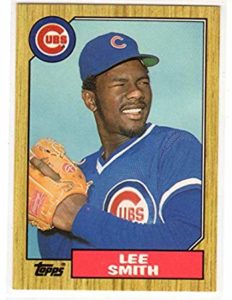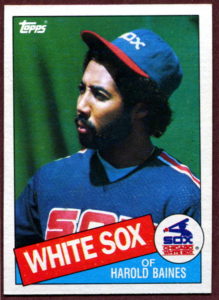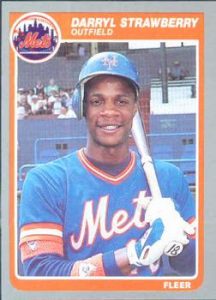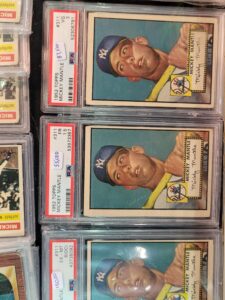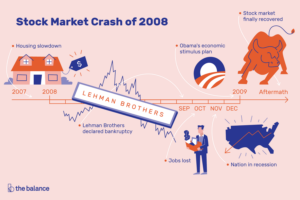Our History of Baseball Card Collecting series continues with a look at the recovery from the bubble bursting, where we are now and where we are going Go here for part one, covering the hobby’s origins. Part two, focusing on the Topps monopoly, can be found here.
Part three, focusing on the golden age, overexpansion and bubble bursting, can be found here.
The Comeback
A lot of lessons were learned, the hard way, from the era of over-expansion and watered-down products. All those rookie cards from the late 1980s and early 1990s that were worth so much back then can be had on eBay these days for chump change.
The explosion of the commercial internet became the hobby’s saving grace in the late 1990s. eBay was as much of a boon to card collecting as the lockouts and strike had been a hindrance. Brick-and-mortar card dealers that were able to make the transition to online-only thrived, as they were able to greatly reduce their overhead, and thus increase profit. This was the era in which the industry itself moved mostly online.
The efficiency and speed of the world wide web was a game-changer. In 2012, Topps created the Topps Bunt digital trading card app, which has since gained over 2 million users in more than 50 different countries.
Card companies counteracted the problem of glut by manufacturing scarcity. In limiting their print runs, the card companies made sure they weren’t flooding the market anymore. At the same time, those bells and whistles we spoke about before really reached another level; or two.
Starting in 1997 with Upper Deck, companies began inserting cards that contained threads from uniforms and pieces of game-used baseball equipment. It was more than just refractors, holograms and colored foil technology now as card companies obtained all manner of memorabilia, from bats, gloves, caps, and even defunct stadium seats to make sure they stood out from the herd. Other cards added real autographs, replacing the reprint of player signatures that had been common on cards for decades.
The Diamond Legacy Michael Jordan card was even embroidered with six diamonds on the card. The luxury line aspect of the hobby had now reached another plane of existence. Once again, the hobby became investment material as the right and rare card, in the correct condition, would reach a very high level in value.
The Present and Future
The 2020s saw a revolution in investing, and the baseball card industry made sure to change with the times. NFTs (Non-Fungible Tokens) and cryptocurrencies took off as usage in investing/brokerage apps surged. This attracted mass numbers of generation Zs and Millenials into all sorts of speculative activities. Sports cards evolved for the digital and blockchain technology age, and today it is big business, to say the least.
Topps, led by former Disney CEO Michael Eisner, saw their net sales rise 23% in 2020 to the level of $567 million, a record high for the company. In early 2021, Topps finally went public via a merger with Mudrick Capital Acquisition Corporation II, which increased Topps valuation to $1.3 billion.
Mudrick Capital invested an additional $250 million in the SPAC deal that made publicly traded shares in Topps finally become a reality. “This is the icing on the cake, going digital completely, with the analog still in place,” Eisner said of the deal.
While the corporate side is seeing off-the-charts growth, there is also a surge on the collector side, at least for a small number of elites. The years 2020-21 saw 15 different individual cards sell for over one million dollars at an auction.
The aforementioned 1952 Mickey Mantle sold for $5.2m this past January, a mark tied by the 2003 Lebron James Upper Deck Exquisite Collection Rookie Patch Autographs #78 Serial numbered #07/23 on April 26, 2021.
The most expensive basketball card of all time, it is followed by the 2018 Luka Doncic Panini National Treasures 1 of 1 Logoman Autograph Serial numbered #1/1, which saw a final hammer price of $4.6m.
Of course, a lot of people still use the phrase “baseball cards” to encompass all sports cards, because baseball cards came along far ahead of the cards for other sports, and it is baseball cards that still resonate the most in our American pop culture.
The idea of baseball being “the national pastime” would have never gained any traction if not for baseball cards.
That is a big part of the appeal of baseball cards right there- opening the pack and seeing what you might get. It’s like being a child and opening your presents on Christmas morning- the surprises await.
Sportscard trading itself is speculation, like playing the stock market, or gambling, there is always a level of valuation that can be won or lost, but it’s not real until you buy or sell.
And it’s this thrill that always keeps us coming back to the world of baseball card collecting, more than a century after it first took root.
Paul M. Banks is the Founding Editor of The Sports Bank. He’s also the author of “Transatlantic Passage: How the English Premier League Redefined Soccer in America,” and “No, I Can’t Get You Free Tickets: Lessons Learned From a Life in the Sports Media Industry.”
He currently contributes to Ravens Wire, part of the USA Today SMG’s NFL Wire Network. His past bylines include the New York Daily News, Sports Illustrated, Chicago Tribune and the Washington Times. You can follow him on Twitter.
